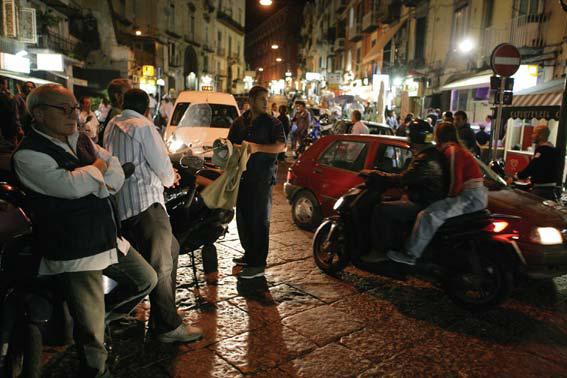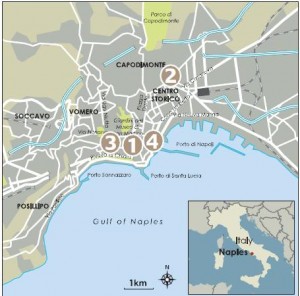 As you steped out into the centre of Naples, your senses are attacked by a cacophony of sounds, smells and sights. On these streets, all manner of life plays itself out. It has always been so. As far back as 1844, Charles Dickens wrote that Naples ‘woke again to Policinelli and pickpockets, buffo singers, beggars’ rags, puppets, flowers, brightness, dirt and universal degradation, airing its harlequin suit in the sunshine, next day and every day singing, starving, dancing on the sea shore’. Today, while the poverty is not quite as wretched, little else has changed. These days Naples is the capital of the scooter: young and old – even entire families – ride on rasping Vespas that obey no rules of the road. In the evening, when the whole of Naples takes to the streets, the young lean against their beloved scooters as they congregate in the piazzas, while on Sundays lovers can be found intertwined on the waterfront, still perched on their mopeds. But the centre of the city is a reminder of what Britain’s bland homogenised town centres have lost. No chain stores here, but small, beautifully presented, individual shops selling pasta, chocolate, wine, antique books, wedding dresses and a treasure chest of other goods. The markets overflow with fruit, vegetables and every kind of seafood imaginable.
As you steped out into the centre of Naples, your senses are attacked by a cacophony of sounds, smells and sights. On these streets, all manner of life plays itself out. It has always been so. As far back as 1844, Charles Dickens wrote that Naples ‘woke again to Policinelli and pickpockets, buffo singers, beggars’ rags, puppets, flowers, brightness, dirt and universal degradation, airing its harlequin suit in the sunshine, next day and every day singing, starving, dancing on the sea shore’. Today, while the poverty is not quite as wretched, little else has changed. These days Naples is the capital of the scooter: young and old – even entire families – ride on rasping Vespas that obey no rules of the road. In the evening, when the whole of Naples takes to the streets, the young lean against their beloved scooters as they congregate in the piazzas, while on Sundays lovers can be found intertwined on the waterfront, still perched on their mopeds. But the centre of the city is a reminder of what Britain’s bland homogenised town centres have lost. No chain stores here, but small, beautifully presented, individual shops selling pasta, chocolate, wine, antique books, wedding dresses and a treasure chest of other goods. The markets overflow with fruit, vegetables and every kind of seafood imaginable.
Neapolitans are rightly proud of their food. This is the home of the pizza. My favourite pizzeria was the Trianon Da Ciro, a no-frills place where workers come for lunch to order huge pizzas which they wash down with beer. As I ate, a couple of large men each demolished two of these pizzas, barely raising their heads to talk as they ate. I ate at a trattoria in the poor Quartieri Spagnoli neighbourhood, where the waiter, proud to have a tourist in his establishment, ordered for me. I enjoyed a delicious feast of vegetables, pasta and fish, accompanied by a local wine, in the equivalent of a greasy spoon café. The Quatieri Spagnoli is the most atmospheric neighbourhood in Naples, a dense, claustrophobic set of narrow streets and alleys. Washing is hung out to dry like flags between the tenement blocks, boys play football, old men play cards and elderly women in the top floors hoist shopping up to their flats in buckets that dangle from a length of rope. Around every corner, a shrine to a saint, often adorned with photos of loved ones, is set into the walls: there’s even a shrine to Diego Maradona, with a strand of his hair enclosed. He received such ‘sanctification’ by bringing Napoli its only championship ever, on a day on which, for once, Naples could lord it over the wealthy northern teams of Juventus and Milan. Maradona makes a fitting latter-day saint for a city that combines the beautiful with the ugly. The Neapolitans are deeply religious, in a superstitious, pagan way; a fact that is hardly surprising, given the looming presence of the still-active volcano Vesuvius. Evidence of macabre practices can be found outside the church of Santa Maria del Purgatorio ad Arco, whose entrance is adorned with bronze skulls. The ritual of adopting skulls of the unknown dead was once practised here.
In return for praying for them, polishing their skulls and leaving them gifts, the dead souls would bless their benefactors once they reached heaven. In 1980 the Catholic Church banned this cult, but it is still believed that a dwindling few continue the practise. One of the most famous skulls is adorned with a bridal veil: it is said that the skull belonged to a woman who died on the eve of her wedding. Newly-weds used to visit the church to receive her blessing. Neapolitans love a wedding. This being Naples, the photo-shoots can take hours, while the couple are photographed in a whole array of theatrical poses in front of statues and outside shops. I came across one couple and, although I did not want to intrude, I was encouraged to take pictures. Neapolitan weddings are very much public exhibitions. As I wandered around taking photographs, concerned Neapolitans constantly warned me to take care. In a city where unemployment reaches 50 per cent in some neighbourhoods, it is not surprising to find that many people turn to crime.
Naples has its own version of Sicily’s mafia, the camorra, and a recent drugs turf war has resulted in the deaths of over 150 people, including many innocent bystanders. It is the gangs of petty criminals that are, however, of more concern to locals. One woman I met had had her handbag stolen on seven occasions. I witnessed one pickpocket at work. A teenager sauntered up behind a group of elderly tourists and calmly put his hand in one of their handbags. He then skipped away, weaving through the traffic. Once across the busy road, he caught my eye and gave me a wink, before disappearing down a labyrinth of alleys. I was amazed at the sheer audacity of this Neapolitan artful dodger. Leaving for the airport, my taxi was late. As my driver raced through the traffic at an even more breakneck speed than usual, it occurred to me that this was what was meant by the phrase ‘see Naples and die’. With one hand on the steering wheel, he leant over to retrieve a book of DH Lawrence’s poetry, and we discussed poetry and Dante before moving on, inevitably, to football, Maradona and the hand of god. It felt like the perfect way to finish a visit to this most enrapturing of cities.
Where to stay
- Hotel Parco Dei Principi Stylish hotel designed by Italy’s most famous twentieth-century architect, Gio Ponti. Fresh and funky, it’s perched on the edge of Sorrento’s spectacular cliffs. In style it resembles a modernist beach cabana, all blue and white.
- Grand Hotel Cocumella Formerly a Jesuit monastery, this elegant hotel overlooking a pretty cliff-top park in Sorrento is furnished with antiques. Guests can take advantage of the hotel’s own tall ship, used for day trips along the Amalfi Coast and to Capri.
- Grand Hotel Vesuvio Since 1882 this seafront hotel has been the local home for royals, celebrities and politicians visiting Naples. Most of the rooms have balconies or terraces overlooking the Mediterranean, Capri, Vesuvius or Sorrento. It’s a case of old-world charm meets modern comfort.
- Hotel Excelsior A splendid palazzo overlooking the promenade. Its rooms are all different and furnished with antiques, creating a fin-de-si?cle feel.
- Grand Hotel Quisisana Traditional and elegantly furnished hotel on the island of Capri, surrounded by enchanting gardens and pretty terraces that overlook the sea and gardens.
- Parker´s Set on a hill overlooking the gulf of Naples and Chiaia beach, this grandiose hotel has catered to the likes of Clark Gable, Bernard Shaw, Boris Yeltsin and David Bowie. Its rooms are decorated with original antique furniture, art and a historical library.
- San Carlo Theatre Enjoy an evening at the opera at the San Carlo Theatre, one of the most important opera houses in Europe, built in 1737, 40 years before the Scala.
- Duomo Cathedral Crane your neck back to take in the imposing central nave of Duomo Cathedral, dedicated to San Gennaro, and built at the end of the thirteenth century.
- Palazzo Reale Wander through the Palazzo Reale, built as an imitation of the Palace of Versailles in the fifteenth century. It was home for the monarchs, and remains one of the city’s best examples of Baroque architecture.
- Castel Nuovo Rise early and head to the Mercato dei Fiori at sunrise, an aromatic flower market held in Castel Nuovo – the thirteenth-century castle that dominates the waterfront.
- POMPEII Jump on a train and head for nearby Pompeii, the Roman city buried by the eruption of Mount Vesuvius in AD 79. Once a week, visitors can come for a night-time view of the ancient city and its still active volcano. (Not shown on map.)


